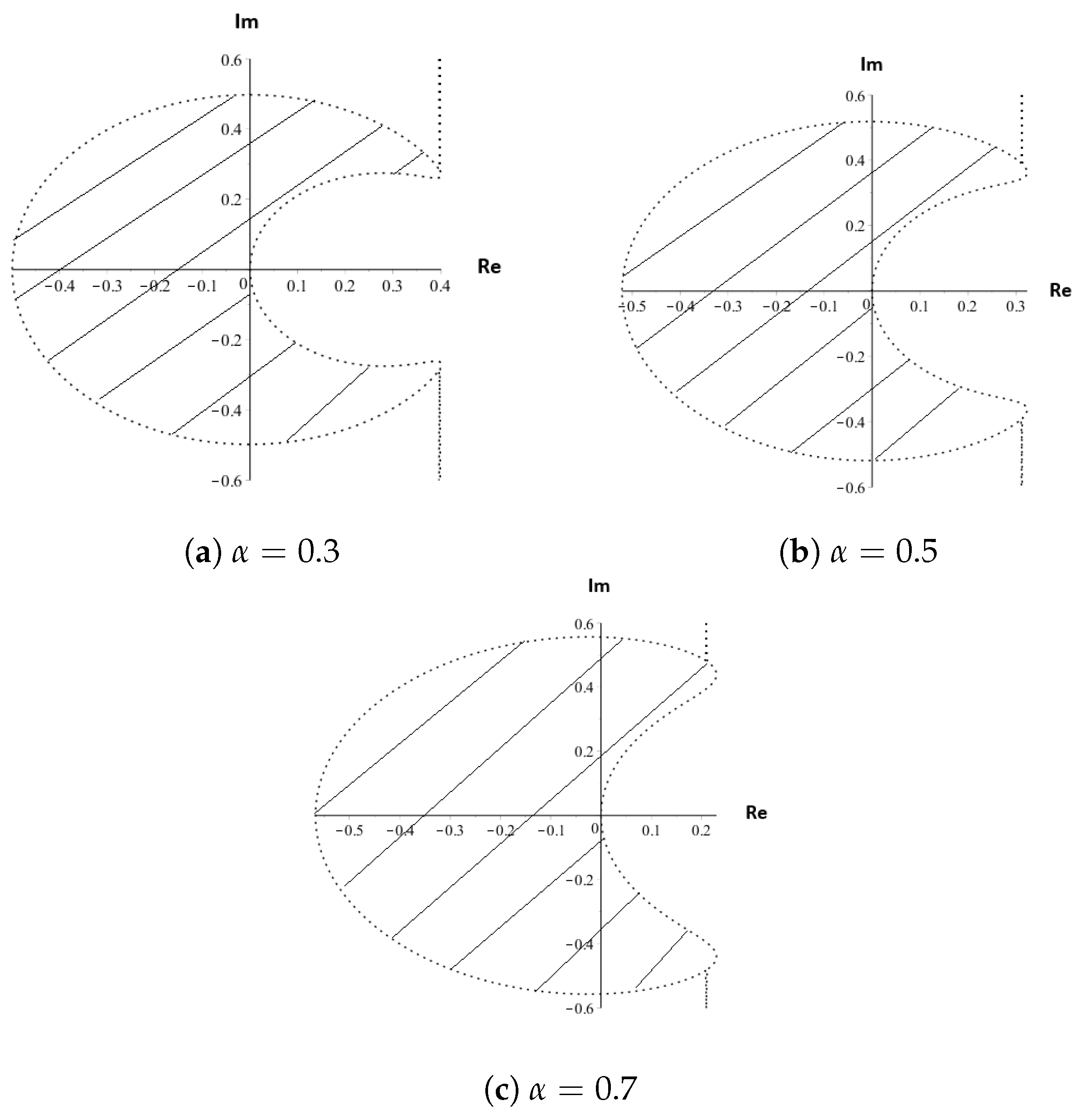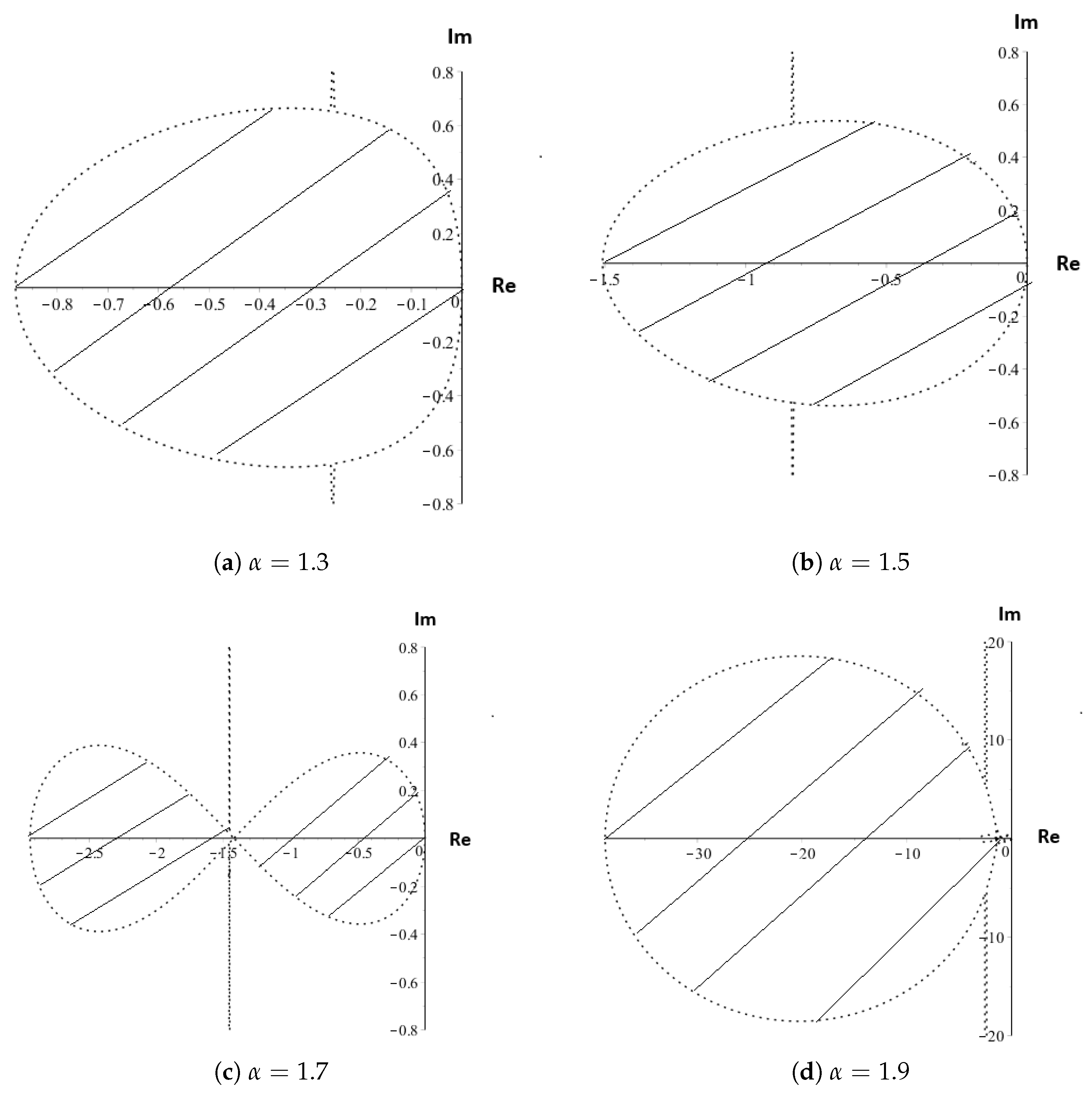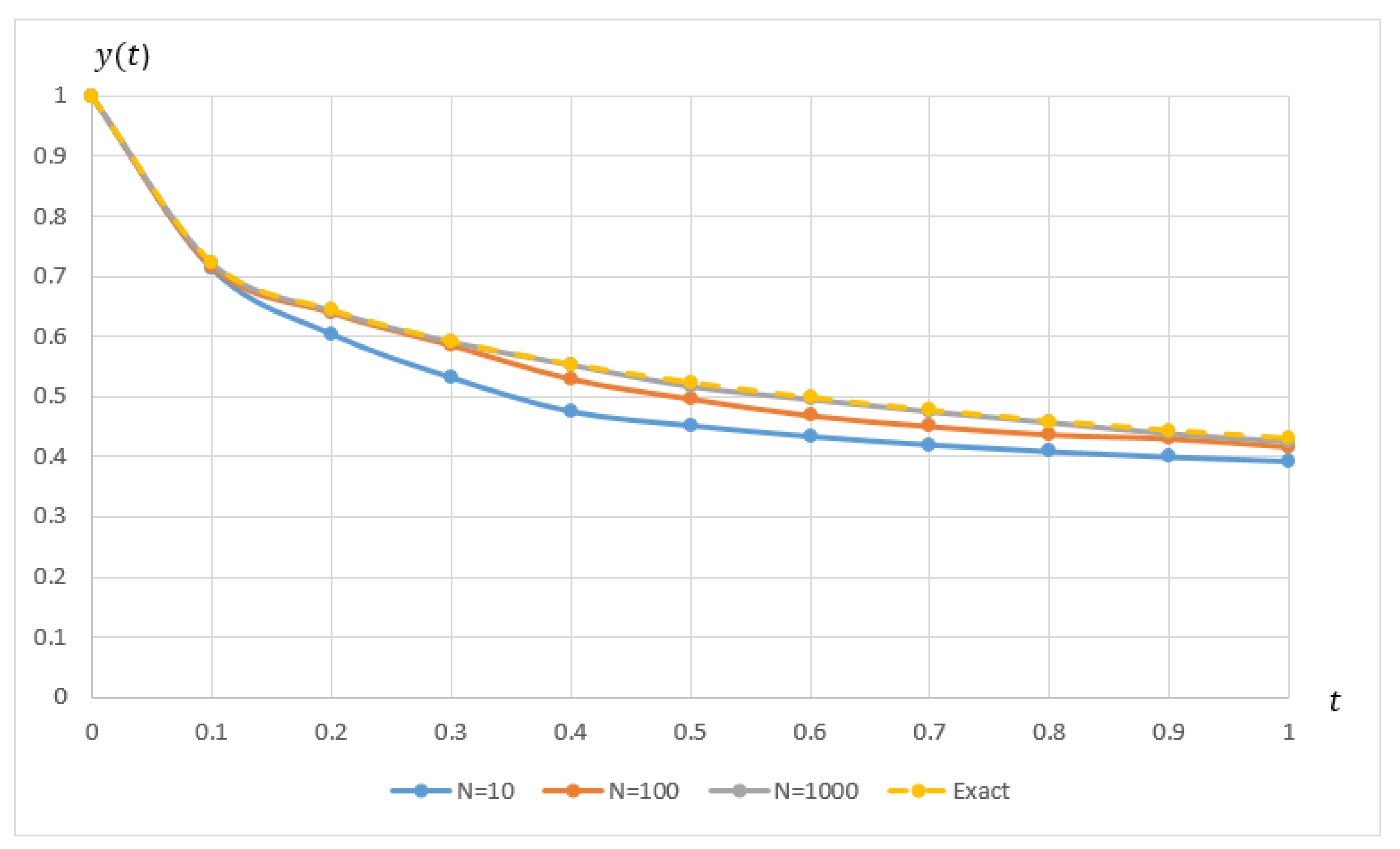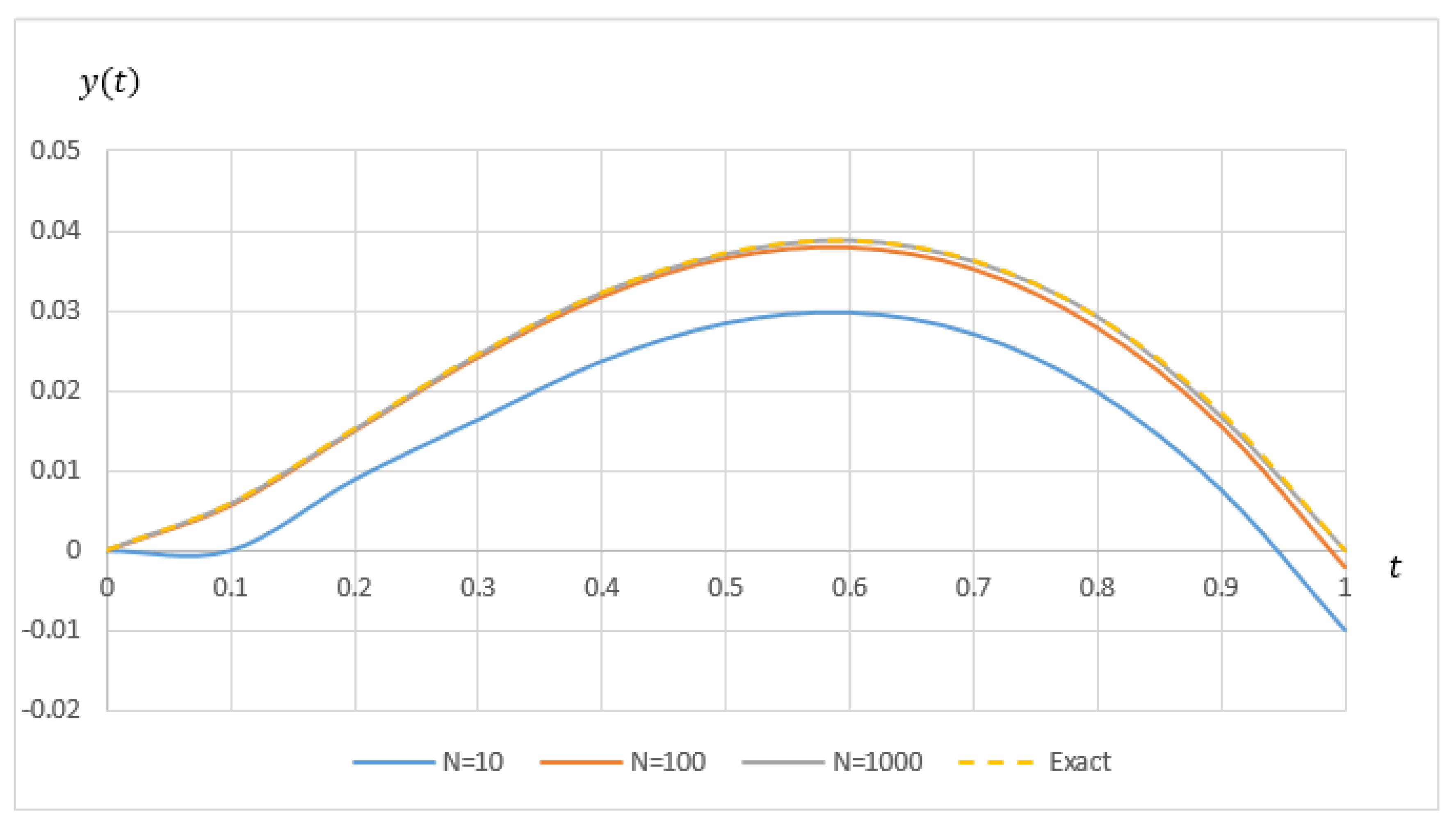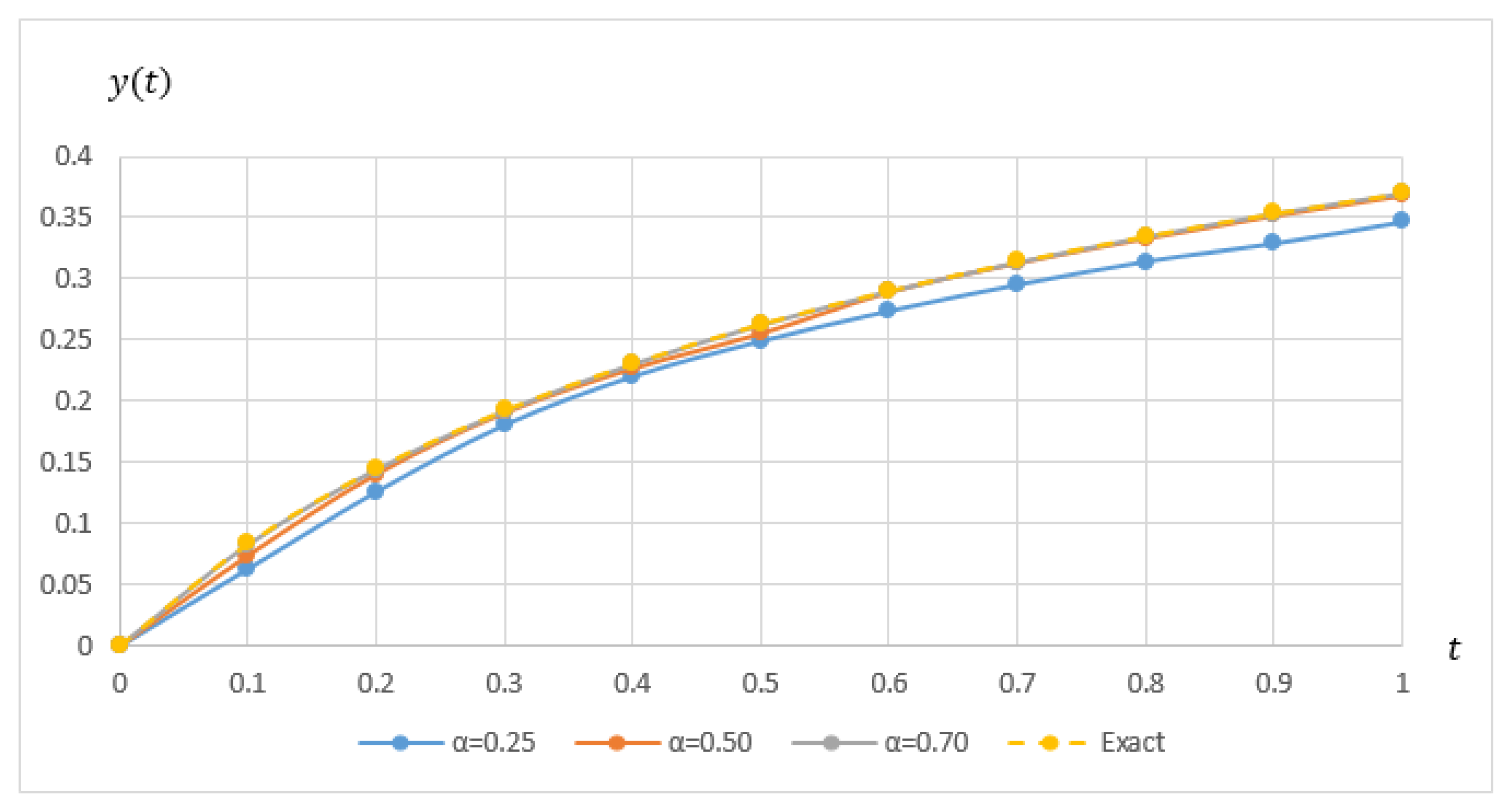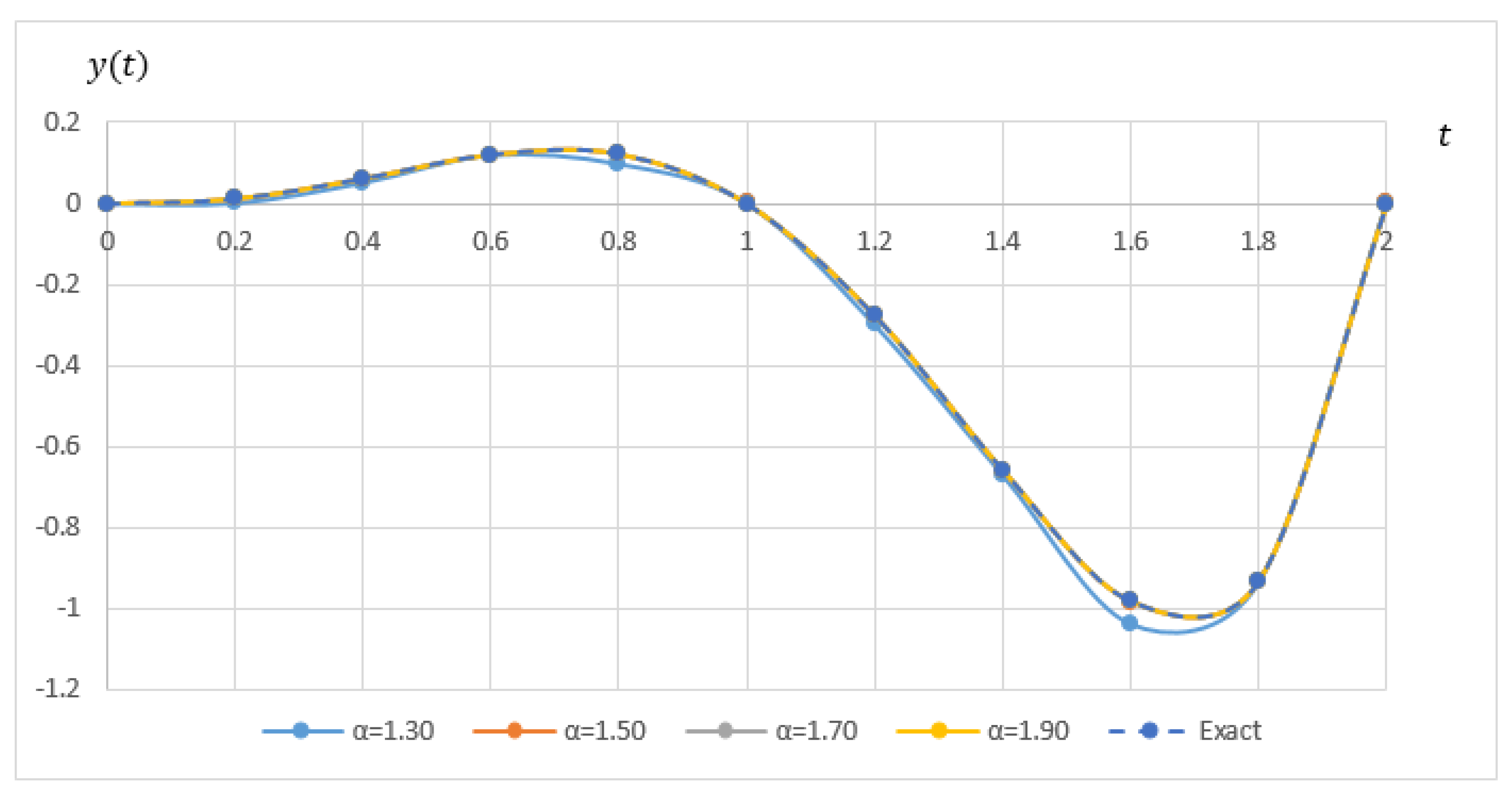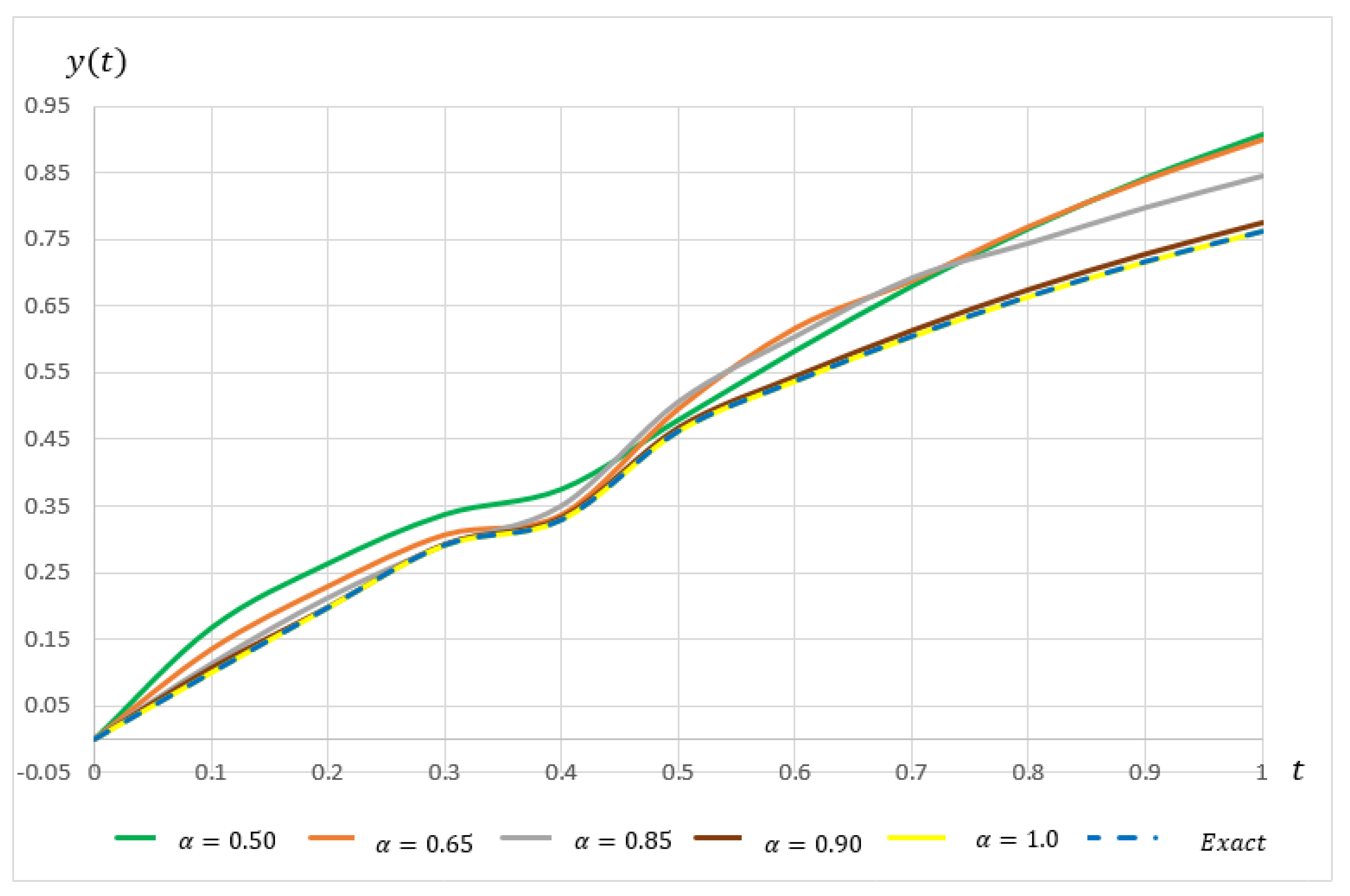1. Introduction
Fractional calculus, particularly fractional differential equation (FDE), has significant applications, which thus plays a crucial role in various fields of science and engineering such as signal processing [
1], control theory [
2], modeling of materials [
3] and diffusion processes [
4]. The work by Woon [
5] mentions the important implications of mathematical applications in other sciences such as physics. In addition, a study by Bagley and Torvik [
6] remarks that fractional modelings are also extensively used in the field of viscoelasticity due to its ability to describe the high-frequency behavior of many viscoelastic materials.
First and foremost, we study the fractional initial value problem (FIVP) in the form [
7],
where
is the fractional order and
denotes the fractional Caputo’s
derivative operator
with
is the Riemann–Liouville differential operator defined as [
8]:
The definition in Equation (
2) has been applied especially in seeking for an analytical solution. However, when it comes to the real application, it might be very challenging. This is because, as pointed out by [
9], specific additional conditions are needed to solve a differential equation in order to obtain a unique solution. These additional conditions for the Riemann–Liouville fractional derivative constitute a certain fractional derivative of unknown solution at the initial points which might result in an unclear physical meaning. Due to this reason, in the present work, we consider the fractional Caputo’s
-derivative,
(in sequel, we shall simply denote as
), which is defined as [
10]
where
and
; see also [
11].
In literature, several analytical and numerical methods have been developed over the past few decades, namely the variational iteration method [
12,
13], homotopy perturbation method [
14,
15] and the Adams–Bashforth–Moulton method [
10] to solve the fractional differential and integral equations. However, in some cases, solving differential equations numerically has proven to be more efficient and convenient compared to analytical solutions especially when dealing with huge and complex problems. Therefore, many researchers have developed numerous numerical methods to solve various kinds of differential equations. For example, research by Podlunby [
16] used the first order finite difference numerical method and managed to solve FDE problems with
accuracy. Following that, Gorenflo [
17] proposed a second order difference method to solve FDE and managed to achieve the desired accuracy. Another well-known numerical method of a predictor–corrector type has been developed by Diethelm et al. [
18] In the study, they developed an algorithm of
(Predict–Evaluate–Correct–Evaluate) where
m is the number of iterations to solve linear and nonlinear FDE. In addition, Galeone and Garrappa [
19] present a study on multistep methods for differential equations of fractional order that concerns numerical treatment of FDE on both implicit and explicit types. They managed to prove that explicit methods in the treatment of FDE give a good numerical solution with good stability analysis. Later, Blaszczyk and Leszczynski [
20] proposed a study on FDE of higher order with a mixture of integer and Caputo derivatives using Euler’s method. They modified the discrete form of the Caputo derivative being dependent on a range of the parameter,
and found that, when the range increases, the number of discrete equations occurring in the algorithm also increases.
The focus of this study is to derive an explicit multistep method based on the concept of the third-order Adams–Bashforth method, where the derivation of the proposed method is given in
Section 2. Furthermore, the analysis of the stability and convergence is demonstrated in
Section 3. Following from there, the implementation of the proposed method is shown in
Section 4. The numerical results for solving six examples of FDEs are presented in
Section 5, where it also includes a discussion on the numerical results obtained to illustrate the efficiency and effectiveness of the proposed method.
2. Fractional Explicit Adams Method of Order 3
This section will introduce a derivation of the fractional explicit Adams method of order 3 (FEAM3).
In the first step, consider the FIVP is in the form [
21]:
It is well-known that FIVP in Equation (
4) can be rewritten in the form equivalent to the Volterra integral equation [
21] as:
Note that, according to Diethelm [
22], it is common to consruct methods for FDE by taking methods for classical (typically first-order) equations and generalizing the concept in an appropriate way. Therefore, we have Equation (
4) as:
Next, simplify Equation (
5) as [
23]:
Now, we propose an approximate solution that involves approximation at the points and . Thus,
- i.
- ii.
Subtracting Equation (
9) from Equation (
8) will yield:
The proposed method is of order 3; therefore, taking the Lagrange interpolation with three interpolating functions of
and
are required to evaluate the approximate solutions as follows:
Substituting Equations (
11) and (
12) into Equation (
10), we obtain:
- i.
The first fractional integral is evaluated as:
Now, consider making substitution
; then:
Thus, the computation for the first fractional integral is given by:
- ii.
Similar to the above steps, the second fractional integral can be computed as in the following form:
Next, making the changes
and
gives:
Therefore, we obtain the computation for the second fractional integral
Now, if we substitute Equations (
16) and (
19) into Equation (
10), then we obtain a numerical scheme for FEAM3 as follows:
Therefore, Equation (
20) is the proposed numerical scheme known as FEAM3. The method analysis and performance evaluation of FEAM3 are discussed in the latter section.
5. Numerical Results
In order to validate the efficiency of the proposed method, six tested FDE problems which consist of single order as
and higher order,
were considered. The computation was done using C programming (CodeBlock). Below are the notations used in the tables:
| N | Number of intervals. |
| h | Step size. |
| Approx. | Approximate solution. |
| Error | Absolute error. |
| FEAM3 | Fractional Explicit Adams Method order 3 (in this research). |
| FAM | Fractional Adams Method [21]. |
| FLMM-3 | Fractional Linear Multistep Method of Order 3 [25]. |
| ATPC | Adams-Type Predictor Corrector Method [18]. |
| SFMoPF | Spline Function Method of Polynomial Form [28]. |
| 3-HOFLMSM | High Order Fractional Linear Multistep Method of 3-order [29]. |
| FVIM | Fractional Variational Iteration method [30]. |
| MHPM | Modified Homotophy Pertubation method [31]. |
Example 1. A simple linear fractional differential equations [21], given The exact solution is , where is the Mittag–Leffler function defined as Example 2. An initial value problem of FDE [25].where the exact solution is given by . Example 3. A problem of FIVP with variable coefficients [18] is given by The exact solution is .
Example 4. A nonlinear initial value problem of FDE [28] is given by The exact solution is as .
Example 5. A problem of higher order nonlinear fractional differential equation [29].where The results are tabulated when where the exact solution is .
Example 6. An application problem of fractional Riccati differential equations [30,31]. The exact solution is when .
Table 1 and
Table 2 demonstrate the absolute error for solving a simple linear FDE of variable coefficient where the exact solution is the Mittag–Leffler function.
Table 1 shows the absolute error of single order FDE as
, while
Table 2 presents the absolute error of higher order FDE as
at different step size,
. Based on these tables, it can be seen that, for each step size,
h, the absolute error decreases as the order of FDE, and
increases. In addition,
Table 3 shows the comparison in terms of absolute error at point,
when solving Example 1 between FAM and FEAM3 as
at
. From the table, it can be seen that FEAM3 managed to produce comparable results as FAM. The performance graph for solving single and higher order of Example 1 are shown in
Figure 4 and
Figure 5 respectively. The graphs illustrate that, for both cases, the approximate solution clearly approaches the exact solution when
N increases.
Table 4 displays the absolute error at each point,
t for solving an initial value problem of FDE in single order as
at different step size,
. The table shows that FEAM3 managed to perform well, whereby, as
h decreases and
approaches
, better accuracy was obtained. In order to observe the efficiency of FEAM3,
Table 5, which displays the absolute error at point,
when solving Example 2 between FEAM3 and FLMM-3 when
at
is also included. Based on the table, it shows that a comparable result is obtained between FEAM3 and FLMM-3. For better analysis, the performance graph for Example 2 is included in
Figure 6 for
at
. Based on the graph, it can be seen that, as
increases, the approximate solutions approach the exact solution.
In addition, the numerical results for solving initial value problem of higher order FDE are tabulated in
Table 6 in the form of absolute error when
as
. The table proved that FEAM3 is also able to perform well in solving nonlinear FDE, where the absolute error decreases when
increases and
h decreases. On the other hand,
Table 7 shows the absolute error of various
at different
h between FEAM3 and ATPC for solving nonlinear FDE of Example 3, where FEAM3 is able to obtain a comparable result as the existing method, ATPC. Additionally, the graph of approximate solution at each point,
t, for solving Example 3 when
for different
N is shown in
Figure 7. The graph highlights that the approximate solution does indeed approach the exact solution as
increases.
Next,
Table 8 shows the numerical result for solving Example 4 when
, while
Table 9 shows the results when
for solving Example 5. Both tables present the approximate solution and absolute errors at each point,
t for different
N. Based on these tables, it can be seen that better accuracy is obtained as
N increases. For comparison purposes,
Table 10 presents the comparison of absolute error between FEAM3 and SFMoPF at each point,
t when
and
in solving Example 4, while
Table 11 demonstrates the comparison of absolute error at each point,
t between FEAM3 and 3-HOFLMSM in solving nonlinear higher order FDE of Example 5 when
and
. From these tables, the results given by FEAM3 are seen to be comparable to the respective existing methods. The performance graph for both examples are shown in
Figure 8 and
Figure 9, respectively, where, as
increases, the approximate solutions approach the exact solution.
This paper also includes solving fractional Riccati differential equation (FRDE). According to [
30], it is well-known that the Riccati differential equation is concerned with applications in pattern formation in dynamic games, linear systems with Markovian jumps, diffusion problems, river flows, and econometric models. Therefore, many researchers have developed several analytical and numerical methods in solving FRDE problems, since it can be considered as one of the examples of application problems in FDE.
Table 12 presents the result on absolute error for solving FRDE problem by using FEAM3 at different intervals,
when
. Based on the table, the absolute error for solving FRDE by using FEAM3 decreases as
N increases. Thus, it gives meaning whereby, as the step size decreases, the approximate solutions approach the exact solutions. For comparison purposes,
Table 13 shows the comparison result of solving the FRDE problem between FEAM3, FVIM, and MHPM when
and
. According to the table, FEAM3 managed to give a comparable result as FVIM and MHPM. Furthermore, a graph shows the approximate solution at each point, and
t for solving the FRDE problem is also presented in
Figure 10, where the approximate solutions do indeed approach the exact solution as
increases. Therefore, this implies that FEAM3 is able to perform well in solving nonlinear FDEs.
